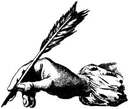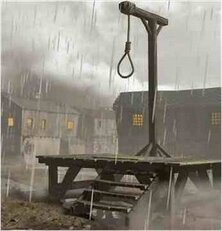 By M.P. Pellicer | Stranger Than Fiction Stories The United States had gained its independence from Britain for only a few years, when a 19-year-old named Barnett Davenport came to work for a family on their farm. Little did they know they had allowed the devil in their midst, who later claimed he was haunted by thoughts of murder. 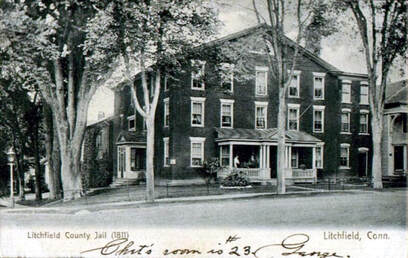 Litchfield County Jail Litchfield County Jail Barnett Davenport could be called a bad seed. He was born in 1760, and thievery came easily to him. By the time he was 15 years old he had a fearsome reputation as a robber. The onset of the Revolutionary War coincided with his 16th birthday, and he joined the Continental Army using the assumed name of Bernard. He fought at Valley Forge and Fort Ticonderoga, but the hardships of war did not agree with young Davenport, and he did return from a furlough. By 1779, he was a deserter, and fought as a paid proxy for other men, but deserted again. Desertion was a crime punishable by death, which is perhaps why he returned to rural Connecticut where he grew up. He came across Caleb Mallory (Mallery), a farmer who owned a grist mill. Using the false name of Nicholas, which was his younger's brother name he gained employment with Mallory, who not only gave him a job, but welcomed the drifter into his home, and gave him a suit of clothing. In the household lived Mallory's wife, Jane, their two daughters and three grandchildren. 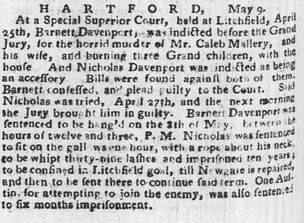 Announcement of Barnett Davenport's arrest c.1780 Announcement of Barnett Davenport's arrest c.1780 On February 3, 1780 Davenport convinced Mallory's daughters to leave on a trip. Around midnight he bludgeoned to death Caleb, Jane and their 9-year-old granddaughter Charlotte who was sleeping with them. His instruments of death was the butt of a musket and a farm tool. He ransacked the home, and changed into his victim's clothing, discarding his bloody ones. Then he set the farmhouse on fire, even though the other two grandchildren were asleep inside, and they perished in the blaze. Later he confessed that he developed an undeniable compulsion to kill the entire family once he met them, "without the least provocation or prejudice against any of them." A manhunt for Barnett brought them to the Davenport home, where they arrested the real Nicholas for supposedly harboring his brother. Barnett was found six days later hiding in a cave in Cornwall. He was taken to Litchfield and thrown into Newgate Prison. There he wrote a 14-page confession of the murder to a minister. He described a fascination for killing and death, months before he crossed paths with the Mallory family. 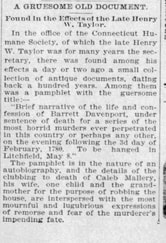 Barnett Davenport's confession was found over 100 years later in private collection c.1894 Barnett Davenport's confession was found over 100 years later in private collection c.1894 This preoccupation with murder had an earlier source, which is when he was an indentured child to John Stilwell. His father had put him in Stilwell's care as a hired farmhand at the age of 9. He was consumed with killing Stilwell, and at the age of 15 stole his employer's horse and was convicted of robbery. For the murder of the Mallory family, he was sentenced to a public whipping and then to be hanged for his crime. His brother who was held for complicity in the crime, was sentenced to 39 lashes and life in prison. He also had to stand by the gallows and watch his brother hang. On May 8, 1780 Barnett Davenport was executed on Litchfield's Gallows Hill, and his body was left hanging on the gibbet. His was not the first body to dance at the end of a rope on that spot. Nicholas escaped, but was recaptured and released two years later, but only on the condition that he remain in New Milford. He died when he was 58 years old. In 1894, among the effects of the late Henry W. Taylor, the secretary of the Connecticut Humane Society an antique document was found, which was Barnett Davenport's confession.
0 Comments
Your comment will be posted after it is approved.
Leave a Reply. |
Stranger Than Fiction StoriesM.P. PellicerAuthor, Narrator and Producer Archives
July 2024
Categories
All
|
Stories of the Supernatural
- Stories of the Supernatural
- Miami Ghost Chronicles
- M.P. Pellicer | Author
- Stranger Than Fiction Stories
- Eerie News
- Supernatural Storytime
-
Astrology Today
- Tarot
- Horoscope
- Zodiac
-
Haunted Places
- Animal Hauntings
- Belleview Biltmore Hotel
- Bobby Mackey's Honky Tonk
- Brookdale Lodge
- Chacachacare Island
- Coral Castle
- Drayton Hall Plantation
- Jonathan Dickinson State Park
- Kreischer Mansion
- Miami Biltmore Hotel
- Miami Forgotten Properties
- Myrtles Plantation
- Pinewood Cemetery
- Rolling Hills Asylum
- St. Ann's Retreat
- Stranahan Cromartie House
- The Devil Tree
- Trans-Allegheny Lunatic Asylum
- West Virginia Penitentiary
- Paranormal Podcasts
"When misguided public opinion honors what is despicable and despises what is honorable, punishes virtue and rewards vice, encourages what is harmful and discourages what is useful, applauds falsehood and smothers truth under indifference or insult, a nation turns its back on progress and can be restored only by the terrible lessons of catastrophe."
- Frederic Bastiat
- Frederic Bastiat

Copyright © 2009-2024 Eleventh Hour LLC. All Rights Reserved ®
DISCLAIMER
DISCLAIMER
 RSS Feed
RSS Feed








